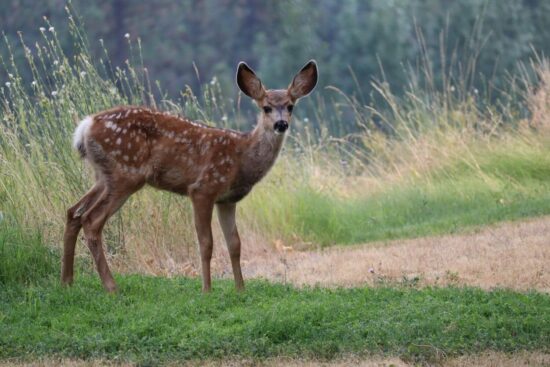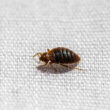Nothing’s more frustrating than finding deer have turned your garden into their personal buffet overnight. These hungry creatures can devour 12 pounds of vegetation daily, and expensive commercial repellents often contain harsh chemicals.
The solution? Create an effective homemade deer repellent using simple household ingredients that are safer and cheaper. Since deer have incredibly sensitive noses (60 times stronger than humans), strong odors can convince them to dine elsewhere.
Success requires starting early, applying consistently, and rotating methods so deer don’t adapt. Here are 12 proven techniques that actually work.
1. Classic Egg and Milk Spray (Most Effective Overall)
This is hands down the best homemade deer repellent according to multiple university studies. The University of Minnesota Extension estimates this simple recipe covers 75% or more of average deer repellent needs at minimal cost.
Why it works so well: When eggs and milk ferment, they create a putrid smell that tricks deer into thinking predators are nearby. This triggers their natural survival instinct to flee the area immediately.
What you’ll need:
- 3 whole eggs
- 3 tablespoons milk or yogurt
- 1 gallon of water
- 1 tablespoon liquid dish soap
- Blender
- Strainer
- Spray bottle or garden sprayer
How to make it: Start by cracking the eggs into your blender and adding the milk or yogurt along with 2 cups of water. Blend everything together until it’s completely mixed. Pour this mixture through a strainer into a gallon jug to remove any chunks that might clog your sprayer. Add the dish soap and fill the rest of the jug with water.
Here’s the important part: let this mixture sit at room temperature for 24 hours before using it. Yes, it will smell terrible, but that’s exactly what makes it so effective. The longer it sits, the more potent it becomes.
How to apply: Pour the mixture into your sprayer and coat all parts of your plants thoroughly. Make sure to spray the leaves, stems, and any fruits or vegetables. Don’t worry about harming your plants; this mixture is completely safe for them.
How long it lasts: This spray typically works for about two weeks unless heavy rain washes it away. The milk contains proteins that help the mixture stick to plants better than water-based sprays.
Best for: All types of garden plants, vegetables, flowers, and shrubs. This method also works on rabbits, groundhogs, and other garden pests.
Pro tip: Make this spray outside or in a well-ventilated garage. The smell can be overwhelming indoors, but once it dries on your plants, you won’t notice it while the deer definitely will.
2. Garlic and Hot Pepper Power Spray
This spicy combination creates a double-barreled assault on deer’s sensitive noses. Research shows that deer have extremely sensitive smell receptors, and these strong scents work like nature’s “keep out” signs.
Why it works: Garlic produces sulfur compounds that deer find revolting, while hot peppers contain capsaicin that creates an unpleasant burning sensation. Together, they create a powerful deterrent that most deer won’t challenge.
What you’ll need:
- 1 whole bulb of garlic OR 2-3 hot peppers OR 3-5 tablespoons cayenne pepper
- 1 gallon of water
- Few drops of liquid dish soap
- Blender (optional)
- Coffee filter or cheesecloth
How to make it: If using fresh garlic, crush the cloves with the flat side of a knife (you don’t need to peel them). For hot peppers, chop them roughly. Add your chosen ingredient to the gallon of water along with a few drops of dish soap to help the mixture stick to plants.
For a stronger mixture, blend the garlic or peppers with 2 cups of water first, then strain through a coffee filter or cheesecloth before adding to the full gallon. This removes chunks while keeping the potent oils.
How to apply: Spray this mixture around the perimeter of your garden and directly on plants that deer target most. Focus on new growth since that’s what deer prefer to eat.
How long it lasts: This spray remains effective for 2-4 weeks in dry weather. Reapply after heavy rain or if you notice fresh deer damage.
Best for: Perimeter protection and non-edible ornamental plants. Be careful using hot pepper sprays near areas where beneficial insects like bees feed.
Safety note: Wear gloves when handling hot peppers and avoid touching your eyes. If using cayenne pepper, make sure it’s finely ground to prevent clogging your sprayer.
3. Irish Spring Soap Barriers
This old-fashioned method has been protecting gardens for decades, and there’s solid science behind why it works. Irish Spring soap contains ingredients derived from animal fat that herbivorous deer find naturally repulsive.
Why it works: The soap contains hydrogenated tallow acid and sodium tallowate, which come from animal fat. Since deer are plant-eaters, these scents signal “predator territory” to their sensitive noses.
What you’ll need:
- Irish Spring soap bars (original scent works best)
- Mesh produce bags, old pantyhose, or cheesecloth
- String or twist ties
- Stakes or hanging points around your garden
How to set it up: Cut each soap bar in half since one bar can protect about a 10×10 foot area. Drop the soap pieces into mesh bags or the feet of old pantyhose. Tie the bags securely, leaving extra string for hanging.
Hang these soap sachets within 3 feet of the plants you want to protect, about 6-10 feet off the ground. You can hang them from tree branches, fence posts, or shepherd’s hooks placed throughout your garden.
How long it lasts: Replace the soap every 4-6 weeks or after extended periods of rain and humidity. The soap needs to maintain its strong scent to stay effective.
Best for: Perimeter defense and areas away from windows or outdoor seating where you don’t want strong soap smells wafting around.
Important tip: Never hang soap directly on plants since the residue can damage leaves and stems. Keep soap bags at least a foot away from plant foliage.
4. Essential Oil Deterrent Spray
For those who want an effective deer repellent that actually smells pleasant to humans, this essential oil blend is perfect. It creates a fragrant barrier that deer hate but people love.
Why it works: Strong aromatic oils overwhelm deer’s super-sensitive smell receptors. Cinnamon, clove, and peppermint create scents that deer associate with danger while masking the appealing smells of your plants.
What you’ll need:
- 1 cup white vinegar
- 1 tablespoon light cooking oil
- 1 teaspoon liquid dish soap
- 20 drops cinnamon essential oil
- 20 drops clove essential oil
- 20 drops peppermint essential oil
- 35-ounce spray bottle
How to make it: Combine the vinegar, cooking oil, and dish soap in your spray bottle first. Add all the essential oils and swirl gently to mix. Fill the rest of the bottle with water and shake well before each use.
How to apply: Spray this mixture on and around your plants every 4-5 days. The oils create a lasting scent barrier that refreshes with each application.
How long it lasts: Essential oil-based repellents can last up to 5 weeks without rainfall, making them more durable than many other homemade options.
Best for: Areas near your home, patios, or anywhere you spend time outdoors. This method smells great to humans while keeping deer away.
Money-saving tip: Buy essential oils in bulk online or look for them at warehouse stores. A little goes a long way, and you can use leftover oils for other household purposes.
5. Coffee Grounds Barrier Method
If you’re a coffee drinker, this method turns your daily waste into garden protection. While there’s limited scientific evidence, many gardeners swear by this approach, and it has the added benefit of enriching your soil.
Why it works: Coffee grounds have a strong, bitter scent that deer find unpleasant. The theory is that this human-world smell signals potential danger to deer’s survival instincts.
What you’ll need:
- Used coffee grounds (save them daily)
- Plastic storage container with lid
- Small scoop or cup for spreading
How to prepare: Save your coffee grounds each day in a container. For extra potency, let them sit in a sealed plastic bag for at least a week. This makes them develop a stronger, more off-putting smell.
How to apply: Spread a thin layer of coffee grounds around the base of vulnerable plants and along garden borders. Focus on areas where you’ve noticed deer damage or tracks.
How long it lasts: Fresh application every 3-7 days works best, especially after rain. Coffee grounds break down quickly and lose their scent, so consistency is key.
Best for: Gardeners who drink coffee regularly and want a zero-cost solution. This method also adds nitrogen to your soil as the grounds decompose.
Bonus benefits: Coffee grounds can also deter slugs, snails, and ants while providing nutrients for acid-loving plants like blueberries and azaleas.
6. Human Hair Deterrent
This unusual method might sound strange, but it’s based on the principle that deer fear human scent. While scientific evidence is limited, many gardeners report success with this technique.
Why it works: Human hair carries our scent, which deer associate with danger. The unfamiliar smell can make deer nervous enough to avoid the area.
What you’ll need:
- Human hair clippings from barbershop or salon
- Old pantyhose or cheesecloth
- String for hanging or tying
How to set it up: Ask your local barbershop or hair salon to save clippings for you (most are happy to help). Stuff the hair into the feet of old pantyhose or wrap in cheesecloth to create “hair sachets.”
Hang these around your garden or scatter loose hair directly on the soil around vulnerable plants. Each hair placement protects about a one-yard radius.
How long it lasts: Replace every 2-3 weeks or after heavy rain washes away the scent. Hair loses its effectiveness once it no longer smells like humans.
Best for: Small garden areas or as a supplementary method combined with other techniques. This works best in areas where deer haven’t become accustomed to human presence.
Reality check: You’ll need quite a bit of hair to protect a large garden, and the effectiveness varies greatly depending on local deer behavior and hunger levels.
7. Predator Urine Application
This method taps into deer’s natural fear of predators like coyotes and wolves. Commercial predator urine products have shown impressive results in university studies.
Why it works: When deer detect the scent of their natural predators, their survival instincts kick in immediately. Colorado State University research found coyote urine more effective than many home remedies including soap and hair.
What you’ll need:
- Commercial coyote or wolf urine (available at garden centers or online)
- Small containers with holes (like yogurt cups)
- Rocks or weights to secure containers
How to apply: Pour a few tablespoons of urine into each container and place them every 10 feet around your garden perimeter. Weight the containers down so they don’t blow over in the wind.
You can also spray the urine directly on plants or use commercial scent dispensers designed for this purpose.
How long it lasts: Reapply weekly and after every rain. The scent needs to stay fresh to maintain effectiveness.
Best for: Large properties with severe deer pressure where other methods haven’t worked. This is particularly effective against elk and larger deer species.
Important warning: Predator urine might actually attract real coyotes or wolves to your area looking for mates. Consider this carefully if you live in areas with large predator populations.
8. Spoiled Milk Spray
This gross-but-effective method uses the power of sour milk to overwhelm deer’s sensitive noses. The rotten smell clouds their ability to detect food sources while making them feel vulnerable to predators.
Why it works: Sour milk creates such a strong, unpleasant odor that it interferes with deer’s ability to smell properly. When their primary sense is compromised, they become nervous and leave the area.
What you’ll need:
- Any type of milk (whole, 2%, skim, or buttermilk)
- Spray bottle
- Blender (if milk becomes too thick)
How to prepare: Leave milk out of the refrigerator for at least 24 hours to develop that truly rotten smell. The goal is to make it as disgusting as possible. If the milk becomes too thick or curdled, blend it with a little water and strain before putting it in your spray bottle.
How to apply: Choose a sunny day after morning dew has evaporated for best results. Spray the sour milk solution liberally on your plants, making sure to coat leaves, stems, and any developing fruits or vegetables.
How long it lasts: The proteins in milk help this spray stick to plants for about 10 days, even through light rain. Heavy downpours will wash it away faster.
Best for: Budget-conscious gardeners who want to use up milk that’s about to expire. This method works on all types of plants without harming them.
Fair warning: This smells just as bad to humans as it does to deer, so apply it when you won’t be spending time in the garden for a few hours.
9. Dish Soap and Vinegar Solution
This simple two-ingredient approach combines the sharp scent of vinegar with the sticking power of dish soap to create an effective deterrent that’s easy on the budget.
Why it works: The acidic smell of vinegar irritates deer’s sensitive nasal passages, while soap creates an unpleasant taste if they try to nibble. Together, they make plants very unappealing.
What you’ll need:
- 1-2 tablespoons Dawn dish soap
- White vinegar
- 16-32 ounces water
- Old rags or cloth strips
- Wooden stakes
How to make it: Mix the dish soap with water in a spray bottle. For extra effectiveness, soak old rags completely in white vinegar and attach them to stakes placed around your garden.
How to apply: Spray the soap solution directly on plants and place vinegar-soaked rags at deer entry points. Re-soak the rags every 7-10 days to keep the scent strong.
How long it lasts: The soap spray lasts 1-2 weeks in dry weather, while vinegar rags need refreshing weekly. Rain reduces effectiveness significantly.
Best for: Small gardens and temporary protection during peak growing season. This method is especially useful for protecting newly planted seedlings.
Budget tip: Use the cheapest white vinegar you can find since you’re not eating it. Save the expensive stuff for cooking.
10. Baby Formula (Hydrolyzed Casein) Spray
This scientifically-backed method might sound unusual, but USDA research shows it’s as effective as expensive commercial repellents. The secret ingredient is hydrolyzed casein, a milk protein that deer find repulsive.
Why it works: A study published in HortScience found that white-tailed deer consistently avoided food sprayed with hydrolyzed casein. This protein triggers the same avoidance response as commercial repellents costing much more.
What you’ll need:
- Baby formula containing Hydrolyzed Casein (look for Enfamil Pregestimil, Nutramigen, or Similac Alimentum)
- Water
- Spray bottle
How to make it: Mix the baby formula powder with water according to package directions. These specialized formulas contain about 17% hydrolyzed casein, which is the active ingredient that deters deer.
How to apply: Spray the mixture on plants every 2-3 weeks, focusing on new growth and areas where deer have caused previous damage.
How long it lasts: This treatment typically remains effective for 2-3 weeks depending on weather conditions.
Best for: Gardeners who want a research-proven method without mixing multiple ingredients. This is especially good for people who are sensitive to strong smells.
Cost consideration: While more expensive than basic DIY methods, it’s still cheaper than most commercial deer repellents and you’re paying for proven effectiveness.
11. Hot Sauce and Garlic Combo
This spicy blend combines the heat of peppers with the pungent power of garlic to create a formidable defense against hungry deer. The multi-ingredient approach increases the chances of success.
Why it works: Hot sauce contains capsaicin, which creates a burning sensation that deer quickly learn to avoid. Combined with garlic’s sulfur compounds, this creates a powerful smell and taste deterrent.
What you’ll need:
- 3 tablespoons hot sauce (the hotter, the better)
- 3 raw eggs
- 3 tablespoons minced garlic
- 1 gallon water
- Blender
How to make it: Blend the hot sauce, eggs, and garlic with a little water to reduce thickness. Once smooth, add the mixture to a gallon jug and fill with water. Shake well before each use.
How to apply: Spray this mixture around your plants and garden perimeter every 2 weeks or after rain. Focus on plants that deer target most frequently.
How long it lasts: This spray remains effective for 2-3 weeks in dry conditions but needs reapplication after heavy rain.
Best for: Vegetable gardens and fruit trees where deer damage is severe. This method works particularly well on crops like beans, peas, and lettuce that deer love.
Safety reminder: Capsaicin can be harmful to beneficial insects like bees, so avoid spraying directly on flowers during blooming periods.


